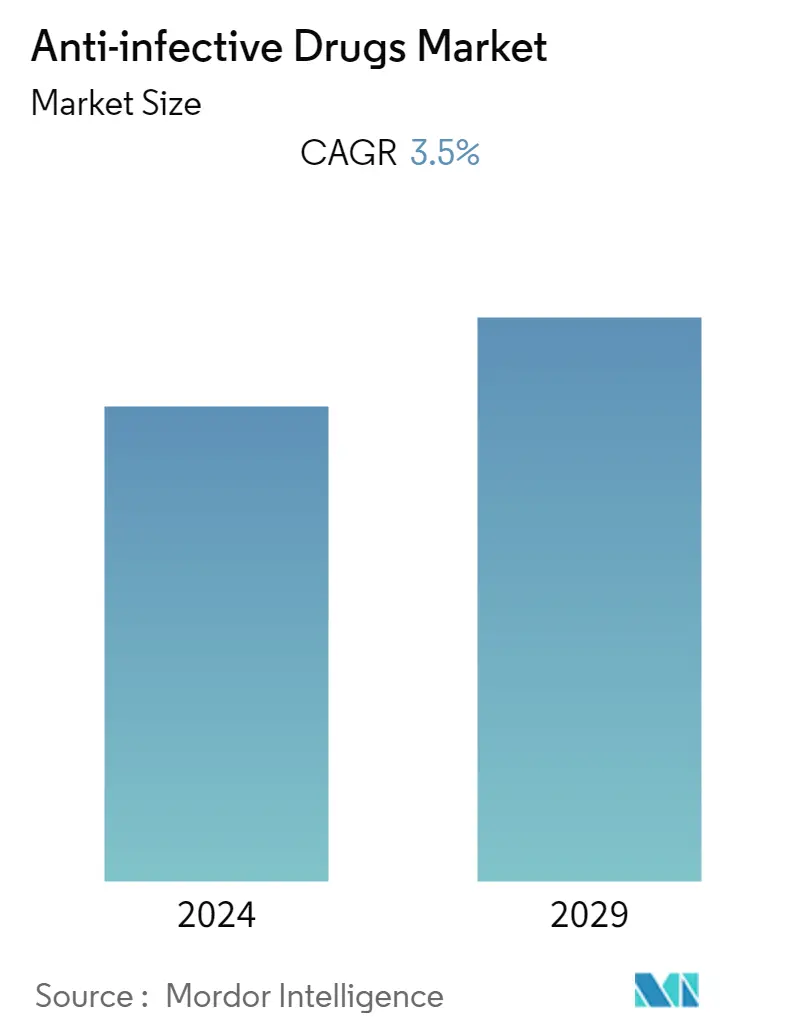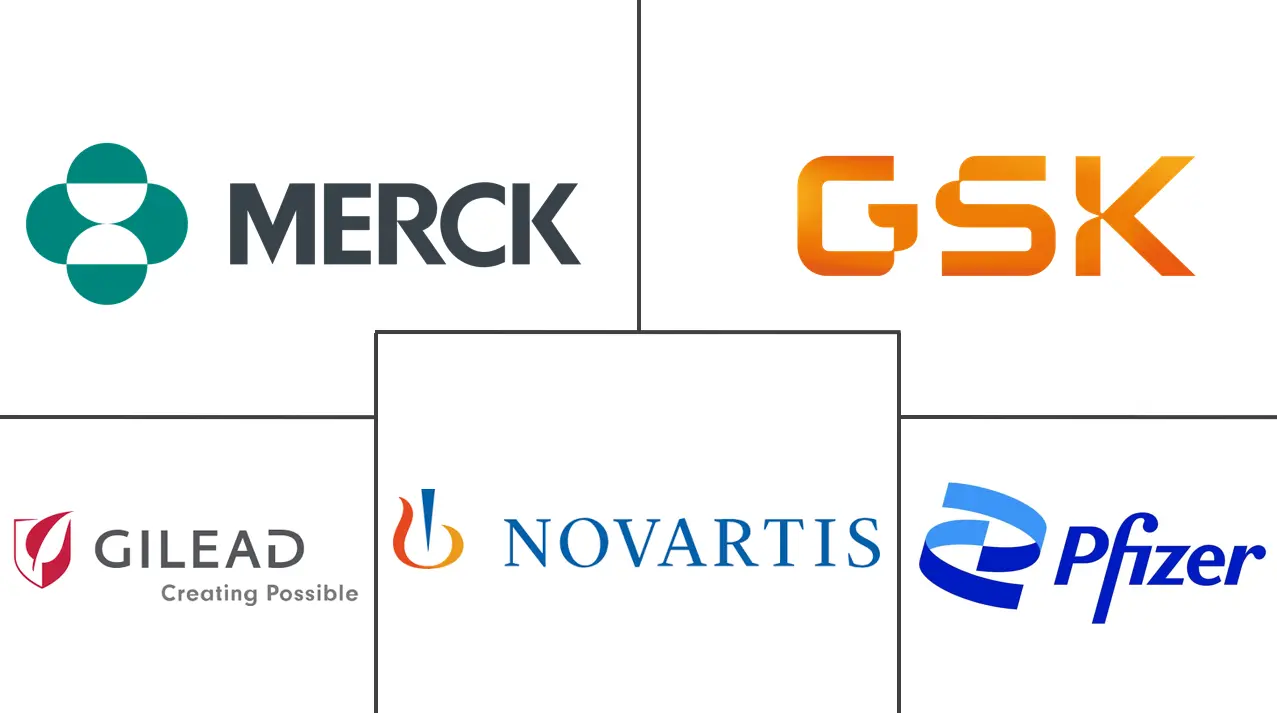Market Size of Anti-infective Drugs Industry

| Study Period | 2019 - 2029 |
| Base Year For Estimation | 2023 |
| Forecast Data Period | 2024 - 2029 |
| CAGR | 3.50 % |
| Fastest Growing Market | Asia Pacific |
| Largest Market | North America |
Major Players
*Disclaimer: Major Players sorted in no particular order |
Anti Infective Drugs Market Analysis
The anti-infective drugs market is expected to witness a CAGR of 3.5% over the forecast period.
During the COVID-19 pandemic, several communities, industries, businesses, and lives were adversely affected owing to the restrictions imposed by various countries. In the initial phase of the pandemic, almost all sectors were affected by the COVID-19 pandemic. However, the use of anti-infective drugs came into focus to prevent the spread of the SARS-CoV-2 virus, along with other infectious agents that worsened the condition of the affected population. For instance, in an article published in the International Journal of Clinical Practices in April 2021, several anti-infective drugs effectively treat the SARS-CoV-2 virus. Nitazoxanide, doxycycline, and azithromycin were highly effective for the symptomatic improvement of mild and moderate COVID19 patients. Dual therapy combining nitazoxanide with azithromycin or doxycycline was more effective than monotherapy. Thus, the wide use of anti-infective drugs to prevent the spread of COVID-19 has significantly impacted the market. Moreover, post-pandemic, the market is growing at a stable pace owing to the decline in the demand for anti-infectives due to increased vaccination and decreasing COVID-19 cases globally.
The primary driving factor for the market's growth is the increasing burden of infectious diseases across developed and emerging markets, such as influenza, diarrhea, hepatitis, and urinary tract infections. For instance, according to the data published by the Centres for Disease Control and Prevention (CDC) in June 2022, an estimated 5% increase in the incidence of catheter-associated urinary tract infections (CAUTIs) in acute care hospitals was observed in the United States in 2021. The source also stated that the highest increase in incidence (9%) was observed in intensive care units (ICUs) of the hospitals. Thus, the growing burden of UTI increases demand for effective treatments such as anti-infectives, boosting market growth.
Moreover, several institutes have started specific initiatives or campaigns to increase awareness about infectious diseases among the public. For instance, in February 2022, the government of India implemented two phases of awareness campaigns for several infectious diseases such as HIV/AIDS, Tuberculosis. The campaign endeavors to generate awareness regarding the prevention of HIV/AIDS and TB, promotion of related services, and reduce stigma and discrimination related to HIV/AIDS and TB. Such a campaign will create awareness of infectious diseases, treatment, and management which is expected to increase the demand for anti-infective drugs, thereby boosting the market growth.
Furthermore, market players are adopted various strategies such as product launches, mergers, acquisitions, and partnerships to stay competitive in the anti-infective drug market, which is also projected to propel the market's growth over the forecast period. For instance, in January 2023, Alkem launched its novel anti-infective in India under the brand name Zidavi. The newly launched Zidavi, a novel combination of ceftazidime and avibactam, is used for multiple drug resistance infections. Similarly, in September 2022, Vernalis Research, a wholly owned subsidiary of HitGen Inc., and Unison Medicines Inc. reported a research collaboration in the United States in anti-infectives.
Hence, the growing burden of infectious diseases and rising awareness campaigns for contagious illnesses, coupled with the strategic activities by market players, are expected to boost the market growth over the forecast period. However, the shortage of resources in healthcare facilities, particularly in emerging markets, and the emergence of anti-infective drug resistance and the associated side effects restrict the growth of the studied market.
Anti Infective Drugs Industry Segmentation
As per the scope of the report, anti-infective drugs/agents are described as substances that prevent infectious agents or organisms from spreading. These are mostly communicable diseases spread by viruses, bacteria, fungi, and other organisms. The Anti-infective Drugs Market is Segmented by Product Type (Antibiotics, Antivirals, Antifungals, and Other Products), Indication (HIV Infection, Pneumonia, Respiratory Virus Infection, Sepsis, Tuberculosis, and Other Indications), Distribution Channel (Hospital Pharmacy, Retail Pharmacy, and Other Distribution Channels), and Geography (North America, Europe, Asia-Pacific, Middle East and Africa, and South America). The market report also covers the estimated market sizes and trends of 17 countries across major regions globally. The report offers the value in USD million for the above segments.
| By Product Type | |
| Antibiotics | |
| Antivirals | |
| Antifungals | |
| Other Products |
| By Indication | |
| HIV Infection | |
| Pneumonia | |
| Respiratory Virus Infection | |
| Sepsis | |
| Tuberculosis | |
| Other Indications |
| By Distribution Channel | |
| Hospital Pharmacy | |
| Retail Pharmacy | |
| Other Distribution Channels |
| Geography | ||||||||
| ||||||||
| ||||||||
| ||||||||
| ||||||||
|
Anti-infective Drugs Market Size Summary
The anti-infective drugs market is poised for steady growth, driven by the increasing prevalence of infectious diseases and strategic initiatives by market players. The COVID-19 pandemic highlighted the critical role of anti-infective drugs in managing viral infections, which significantly impacted market dynamics. Post-pandemic, the market continues to expand due to the persistent burden of diseases such as influenza, hepatitis, and urinary tract infections, particularly in developed and emerging markets. Awareness campaigns and public health initiatives, such as those in India, aim to educate the public about infectious diseases, further fueling demand for anti-infective treatments. Additionally, market players are actively engaging in product launches, mergers, and collaborations to enhance their competitive edge, contributing to the market's growth trajectory.
The antiviral segment is also experiencing growth, driven by the rising incidence of viral diseases like HIV/AIDS and hepatitis. The demand for effective antiviral treatments is increasing, supported by ongoing research and development efforts. Market players are focusing on producing novel antiviral drugs, with significant activities such as Merck & Co.'s licensing agreement for COVID-19 treatment and Gilead Science's FDA approval for a new HIV medication. The North American region is expected to maintain a significant market share, supported by advanced healthcare infrastructure and high disease prevalence. Key players in the market, including Novartis AG, Merck & Co., and Gilead Sciences, are actively launching new products and obtaining regulatory approvals, intensifying market competition and driving growth.
Anti-infective Drugs Market Size - Table of Contents
-
1. MARKET DYNAMICS
-
1.1 Market Overview
-
1.2 Market Drivers
-
1.2.1 Growing Prevalence of Targeted Diseases
-
1.2.2 Growing Initiatives for the Awareness of Infectious Diseases
-
1.2.3 Increasing Investments on R&D Activities of Anti-Infective Drugs
-
-
1.3 Market Restraints
-
1.3.1 Emergence of Anti-infective Drugs Resistance and Side Effects Associated with Anti-infective drugs
-
1.3.2 Shortage of Resources in Low- and Middle-income Countries (LMIC)
-
-
1.4 Porter's Five Forces Analysis
-
1.4.1 Threat of New Entrants
-
1.4.2 Bargaining Power of Buyers/Consumers
-
1.4.3 Bargaining Power of Suppliers
-
1.4.4 Threat of Substitute Products
-
1.4.5 Intensity of Competitive Rivalry
-
-
-
2. MARKET SEGMENTATION (Market Size by Value - USD Millions)
-
2.1 By Product Type
-
2.1.1 Antibiotics
-
2.1.2 Antivirals
-
2.1.3 Antifungals
-
2.1.4 Other Products
-
-
2.2 By Indication
-
2.2.1 HIV Infection
-
2.2.2 Pneumonia
-
2.2.3 Respiratory Virus Infection
-
2.2.4 Sepsis
-
2.2.5 Tuberculosis
-
2.2.6 Other Indications
-
-
2.3 By Distribution Channel
-
2.3.1 Hospital Pharmacy
-
2.3.2 Retail Pharmacy
-
2.3.3 Other Distribution Channels
-
-
2.4 Geography
-
2.4.1 North America
-
2.4.1.1 United States
-
2.4.1.2 Canada
-
2.4.1.3 Mexico
-
-
2.4.2 Europe
-
2.4.2.1 Germany
-
2.4.2.2 United Kingdom
-
2.4.2.3 France
-
2.4.2.4 Italy
-
2.4.2.5 Spain
-
2.4.2.6 Rest of Europe
-
-
2.4.3 Asia-Pacific
-
2.4.3.1 China
-
2.4.3.2 Japan
-
2.4.3.3 India
-
2.4.3.4 Australia
-
2.4.3.5 South Korea
-
2.4.3.6 Rest of Asia-Pacific
-
-
2.4.4 Middle East and Africa
-
2.4.4.1 GCC
-
2.4.4.2 South Africa
-
2.4.4.3 Rest of Middle East and Africa
-
-
2.4.5 South America
-
2.4.5.1 Brazil
-
2.4.5.2 Argentina
-
2.4.5.3 Rest of South America
-
-
-
Anti-infective Drugs Market Size FAQs
What is the current Global Anti-infective Drugs Market size?
The Global Anti-infective Drugs Market is projected to register a CAGR of 3.5% during the forecast period (2024-2029)
Who are the key players in Global Anti-infective Drugs Market?
Merck & Co., Inc, Gilead Sciences, GlaxoSmithKline PLC, Pfizer Inc and Novartis AG are the major companies operating in the Global Anti-infective Drugs Market.

